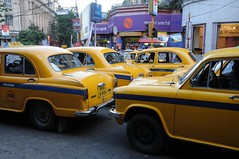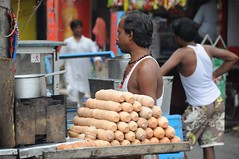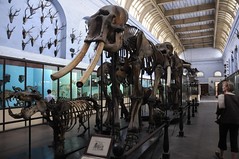The first thing that struck me was how this place had caught hold of moment in time and not let go. The timeline has been ripped up and the historical pieces have been scattered all over. Fragments of 1950s England, a shred of 19th century Asia, a medieval scrap and then there is the modern strand weaving throughout the rest.
Stepping foot outside the airport after our eventful flight from Bangkok (it made the newspapers the next day due to a rowdy drunken man seated in front of us duly arrested on the tarmac), I was greeted by a fleet of 1950s vintage yellow Hindustan Ambassador taxis gleaming brightly in the sun. Every taxi here harks back to that golden age of round fenders and chrome bumpers; I guess if it ain't broke don't fix it.

Ambassador fleet
We got our ride into town in the back of one. With bench seats in the front, climate control via a rolled down window, shutting off the engine at traffic lights, and picking up extra passengers along the road, it was a great way to enter the centre of town.
Removing our packs from the cavernous boot another era struck us, as we were immediately greeted by a rickshaw runner touting his foot-powered vehicle. Surely Kolkata is the only place left on the planet where you can be pulled around on a wooden-spoked cart by a man with bare feet. After five days here we are still yet to use their services. It seems demeaning for me who is perfectly capable of walking to be pulled along by skinnier man with his cart. Then again, it is their way to make a living.
Checking in to the mouldy hotel we stayed in for the first night (we promptly moved out the next morning), we discovered another legacy of the British: their centuries old bureaucracy. We waited for what seemed almost half an hour as the ledger was carefully filled out and all our details were neatly written in – including father's name, where we had been, where we going – and then again for the receipt as we paid.
Escaping the paper work we took to the streets. The streetside sights we have seen while walking – and we have walked a fair way over this spread out city – are things you don't forget in a hurry. It is here that the eras of time really mingle, from ancient ways to the modern.
A typical amble will take you past tiny shop fronts offering services ranging from automotive parts to astrology readings, or the sight of holy Hindu cows outside of halal butcher shops. Food and drink sellers will be whipping up their concoctions of sweets, roti, curries, fresh lime or sugar cane juice and the ever present and my favourite chai (a sweet milky tea in a throw-away terracotta cup, which you have the satisfaction of smashing in the gutter).

Cup of chai?
The amble will take you down traffic filled streets full of not only the yellow Ambassadors but their white brothers owned by Government departments. If you pass these government buildings there will be multitudes of them parked with their drivers, some with "On Duty" signs in their windows. I can just imagine scenes inside the government buildings similar to the start of Monty Python's The Meaning of Life. Rows of desks with clerks and typewriters with fans whirring overhead.
Further on the wander you will be bound to see sights not particularly fetching for the eye. Men pissing into gutters without care for who is around. Children tagging you for a block making hand to mouth gestures are hard to shake from your person as well your mind. Then there are the occasional more sedentary ones, waving stumps at you to gain your attention for some coins in their cup. A man face first on the ground with two short arm stumps flapping about like a seal would have been comical if it wasn't so tragic.
There will also be at some point a beggar woman and her lolling baby. I made the mistake of trying to engage a local shopkeeper to tell me the Bengali words for "please, go away". When the man proceeded to inform me that they were not beggars but only did this out of habit, I was a tad shocked. If someone asks you for money isn't this begging? I politely argued that point.
The shopkeeper conceded, but this unsettled me and made me ponder the best way to approach the beggar hassle. Ignore or give to each of them. Wouldn't handing out money just be perpetuating the begging? I have seen numerous charities giving food handouts. Besides if I gave to every beggar on the street I wouldn't have any money myself.
On these extended strolls we have also visited the traditional sights. The crumbling government buildings from the colonial era when Calcutta was the capital: Dalhousie square, the ornate Writers Building and General Post Office, now overgrown compared to early black and white photos. Then there is the grandeur of the Victoria Memorial – an almost squat Taj Mahal like structure built for the dead queen – one of the buildings from that period which is kept in good condition. The old cemetery of the Raj also still remains.
Sights here have been religious too. We visited the serene resting place of Mother Teresa, and watched the devout come and pray on her tomb. We then contrasted that with a visit to the sacred Hindu Kali temple, where we were jostled, pushed and shoved trying to get a glimpse of the black-skinned three eye god. Kali is very demanding and outside of her enclosure is the sacrificial alter where a goat is brought daily and once a year a buffalo.
Then there was a trip to the Indian Museum, something that looks like it hasn't changed since the British left. Rooms full of dusty cabinets full of dusty rocks are in one section, but more rewarding were the large complete skeletons of elephants and whales as well an interesting wing on the ethnology of the various tribal groups scattered throughout India.

Specimens in the Indian Museum
So with most of the sights out of the way, it is time to move on and tonight we do on the Darjeeling Mail. It is perhaps good timing to be leaving as the rains have finally hit us while we have been here. There was concern before we came as to the state of the monsoon, but with relief we have had mostly rain free days. Which of course has made it extremely hot and humid.
Buying tickets for the train was a venture into the realm of the paper pushing clerks. With the only sign a "May I help you" and a person sitting behind it who wouldn't help, it took us a while to work out the system. Eventually after helping myself to a form and more paperwork and waiting, we had some tickets out of the city.
The train we will catch is actually not to Darjeeling but it takes us near enough to get there easily. I would have liked to take the Darjeeling Express and behave like Adrian Brody or Owen Wilson, but unfortunately there is no Darjeeling Express so the Mail will have to do. Whatever is it called it will be my first Indian train. I am sure this will be start of a long affair.
No comments:
Post a Comment